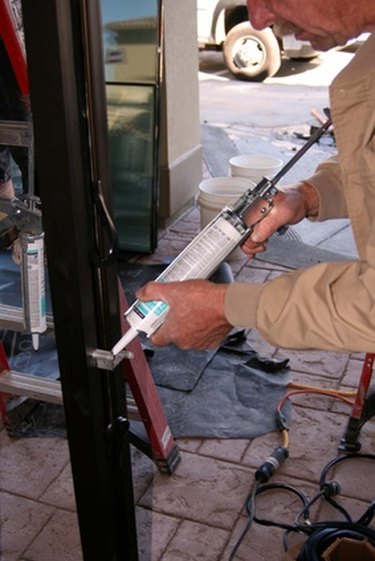
Many builders consider polyurethane caulk to be the ultimate sealant. Unfortunately, this sticky putty-like substance requires the use of mineral spirits during application and clean up, making it difficult to apply to surfaces in many cases.
Safety Precautions
Video of the Day
Always make sure that your work area is well ventilated before you begin using polyurethane caulk so that you don't end up inhaling potentially toxic fumes. Wear protective gloves, eyewear, and work clothes that you don't mind getting caulk on: it probably won't come off in the wash. Always follow the manufacturer's directions to prevent accidental injury.
Video of the Day
Clean Up
Clean up any uncured caulk with a paint thinner or acetone solvent. If the polyurethane caulk comes into contact with skin, wipe it off immediately with a paper towel and wash the area thoroughly with soap and water. If any uncured residue remains, remove it with petroleum jelly, baby oil or mineral oil. The caulk actually works by bonding to the surface at the molecular level, and if you don't wash it off quickly, it will bond to your skin and take several days to come off.
Surfaces
Polyurethane caulks adhere well to surfaces made out of vinyl, cedar wood, aluminum siding, aluminum gutters and brick. The caulk doesn't stick to polycarbonate plastics, which appear in bubble-type skylights.
Painting
Paint blocks out UV rays and if you do not paint and protect the caulk from the sun, it will dry up and turn into an ugly chalk-like substance. As with most paintable caulks, polyurethane caulk must set or cure before you can paint it. Polyurethane caulk can take up to seven days to cure, so you should wait a week before taking your paintbrush to it. If you don't plan on painting the caulk, look for one that has good UV resistance, such as marine caulk.
Drying Out
To stop the caulk from drying, try wrapping the end of the open tube with a double layer of plastic wrap and then taping it tightly shut to keep in moisture.
Labeling
If you cannot choose which brand of polyurethane caulk to use, look at the packaging for the warranty claims. The longer the warranty lasts, the better the caulk will be. Manufacturers also place expiration dates on the labeling, and it may pay to find one that isn't about to expire soon. (Otherwise, it may dry up on you before you can finish using it.)